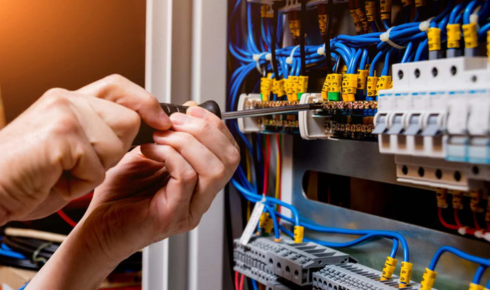Key Takeaways
- Regular upgrades and maintenance to residential wiring systems can enhance household safety, energy efficiency, and property value.
- Modern electrical standards ensure homes are equipped to support today’s increasing number of devices and appliances.
- Early recognition of wiring issues prevents fire hazards and costly repairs.
- Hiring trained professionals is key for safe, code-compliant results.
- Smart and eco-friendly wiring options help future-proof your home.
What Are Residential Wiring Systems?
Every home uses an intricate network of wires, outlets, switches, junction boxes, and a central electrical panel to power its daily operations. Residential wiring systems deliver electricity from the main utility source to every part of your living space—lighting, heating and cooling, entertainment, security, kitchen appliances, and more. These systems are carefully designed to manage the power loads of modern homes, safely distributing voltage through insulated copper or aluminum conductors and protecting your property with circuit breakers or fuses. The importance of professionally installed and maintained electrical wiring systems Philadelphia PA, cannot be overstated, as these systems underpin everything from your refrigerator’s smooth operation to your ability to charge multiple devices simultaneously. Investing in modern wiring supports technology-driven lifestyles and gives peace of mind that your electrical backbone is secure.
Benefits of Upgrading Your Home’s Electrical Wiring
The advantages of updating your home’s wiring systems go beyond just performance—they are grounded primarily in safety. With aging wiring or substandard installations, risks like electrical shocks, arc faults, and unexpected surges increase. According to the U.S. Fire Administration, electrical malfunctions account for an average of nearly 24,000 residential fires yearly in the United States. When you upgrade your wiring, you prioritize the safety of your loved ones and reduce your risk of fires sparked by overloaded circuits or deteriorating insulation.
- Safety First: Modern codes require features such as ground wires, AFCI (arc-fault circuit interrupters), and GFCI (ground-fault circuit interrupters) outlets, which help detect abnormalities and shut off power before a serious incident occurs.
- Efficiency: New wiring facilitates the uninterrupted operation of today’s energy-hungry and sensitive electronics, making it less likely you’ll experience nuisance outages or dangerous overloads. Upgraded wiring can also help you lower monthly energy bills by reducing waste caused by inefficiencies.
- Value Boost: Real estate studies have shown that buyers prefer properties that are already equipped with modern electrical infrastructure. Upgrades can make your home more attractive on the market. In many cases, homeowners find that insurance companies offer more favorable terms or lower rates after verification of code-compliant wiring.
Proactive updates ultimately safeguard both your family’s day-to-day activities and your property’s longevity.
Common Indicators That Wiring Needs Attention
Detecting problems with your home’s wiring early can prevent inconvenience and danger. Warning signs of wiring troubles aren’t always hidden behind walls—they often appear as everyday annoyances or subtle clues. If you regularly suffer from lights that flicker or dim unexpectedly, experience circuit breakers that trip without an apparent cause, or notice wall plates and outlets that feel unusually warm, it’s time for a professional inspection. Other red flags include persistent burning odors, strange buzzing noises from electrical components, or visible scorching or sparking from outlets and switches.
Many older homes, especially those constructed before the mid-1970s, may still have original knob-and-tube or aluminum wiring. These outdated methods weren’t designed for today’s demanding appliances and often lack grounding or insulation, raising the risk of deterioration and fire. According to the National Fire Protection Association’s electrical fire safety research, many avoidable electrical fires are linked to faulty wiring or negligent maintenance. If your home’s electrical system is due for an update or you’re experiencing these warning signs, don’t delay seeking expert help.
Popular Wiring Upgrades and Smart Home Adaptations
Today’s homeowners expect their electrical systems to do more than ever. Upgrading to grounded, three-prong outlets not only brings you up to current safety codes but also prepares your home for sensitive electronics and surge-prone appliances. Circuit protection improvements, such as AFCIs and GFCIs, add a shield against hidden electrical faults that could threaten household safety. Integrating smart home wiring gives you the power to automate lighting, climate control, and security systems, making daily life more convenient and energy-efficient.
- Adding dedicated circuits and outlets for heavy-use areas like kitchens or home offices
- Wiring for networked smoke alarms, security systems, and motion sensor lighting
- Preparing the electrical panel for future-ready technologies, such as solar panels or electric vehicle charging stations
- Installing energy management systems to help monitor and reduce electricity usage and support sustainability goals
According to energy studies, energy-efficient LED lighting and automated home systems can collectively cut electricity consumption by as much as 25%, reducing wear on your entire electrical system while saving money month after month. Investing in these upgrades moves your household into a new era of safety, convenience, and reduced environmental impact.
How to Choose a Qualified Professional for Wiring Services
Residential wiring work requires a blend of technical knowledge, regulatory understanding, and hands-on skill. Choosing a licensed, insured, and certified electrician protects your investment and your family. When vetting service providers, check for proper credentials and ask to see proof of insurance. It’s also wise to get several detailed written estimates to know exactly what work is included and how extras or unexpected issues will be managed. Communication is key—look for someone who listens carefully to your needs, explains the process in plain language, and answers all your questions.
Getting comfortable with the process starts by knowing what to ask. The New York Times Wirecutter shares expert tips on hiring an electrician, suggesting homeowners ask about the provider’s experience with specific upgrades, smart home system integration, and warranty coverage for their work. Good electricians will be happy to discuss their licensing, approach to safety, project timelines, and even recent similar jobs so you can confidently select.
Step-by-Step: What to Expect During a Wiring Project
- Initial Inspection: Your property’s current electrical setup is thoroughly evaluated, including load capacity, safety risks, code compliance, and your own goals for the upgrade or repair.
- Permitting and Safety: Qualified electricians will apply for the necessary permits and plan work to minimize hazards. Protective covers, drop cloths, and targeted power shut-offs help protect your property and daily routine during installation.
- Installation and Upgrades: Wires, outlets, switches, and circuit breakers are replaced or added according to the plan, strictly adhering to safety standards and best practices, including careful routing through walls, floors, and ceilings for minimal disruption and a neat finish.
- Testing & Final Walkthrough: Every new and existing circuit is carefully tested for function, connection tightness, and safety. At the project’s end, most professionals offer a detailed walkthrough to explain the improvements, answer questions, and ensure your satisfaction.
Open and frequent communication at every step prevents confusion and can help the project stay on schedule and within budget.
Maintaining Your Electrical System After Upgrades
Even after completing the project, maintaining a safe residential wiring system requires occasional effort. Homeowners should test smoke detectors and GFCI outlets monthly, inspect exposed cords and plugs for damage, and keep an eye out for unexpected electrical gremlins (buzzing, flickering, or heat build-up).
- Schedule routine professional inspections every 5–10 years
- Address any mysterious electrical symptoms promptly rather than ignoring them
- Keep access to the main electrical panel clear for emergencies
Attentive maintenance now preserves the value of your investment and ensures long-term peace of mind.
Cost Considerations and Long-Term Value
The total expense for residential wiring services depends on the size of your home, the complexity of the work, the required accommodation for new tech, and whether outdated wiring needs removal. While comprehensive rewiring projects can be significant investments, many homeowners find that energy cost savings, improved safety, reduced repair risk, and higher resale values make these projects well worth the price. Additionally, upgraded wiring may unlock discounts from your insurance provider, thanks to a lowered risk profile.
FAQs: Navigating Residential Wiring Services
- How often should residential wiring be inspected? Professionals recommend a comprehensive inspection every five to ten years or after major renovations or additions of heavy appliances.
- Is it safe for homeowners to update wiring themselves? Due to safety and legal code requirements, even basic electrical work should be left to a certified professional.
- Will smart home features require a complete rewiring? Many upgrades can be installed with existing wiring, but significant technological leaps—such as whole-house automation or solar power integration—often need dedicated circuits or panels.
- Are wiring projects very disruptive? Most professional teams work room by room, keeping interruptions to a minimum and cleaning up thoroughly at project completion.
Prioritizing timely upgrades, regular maintenance, and professional expertise in residential wiring systems services offers homeowners security, comfort, and flexibility to enjoy everything today’s technology offers.



